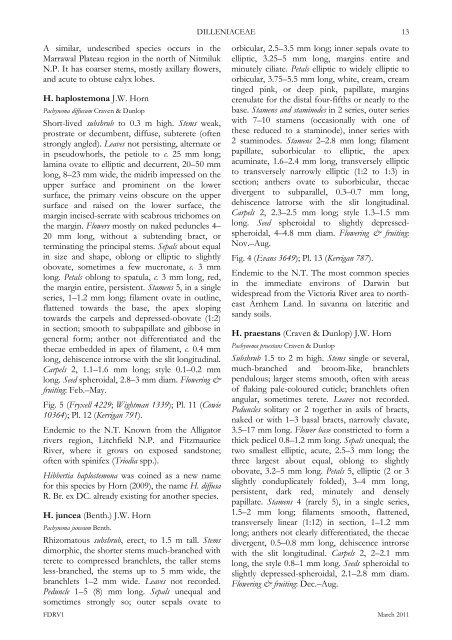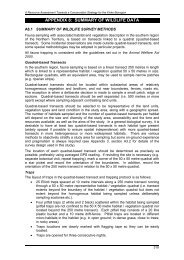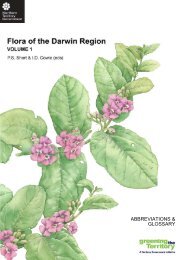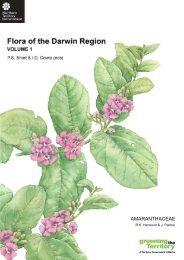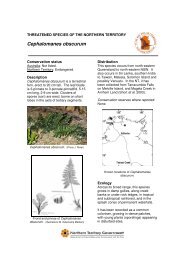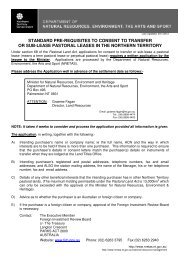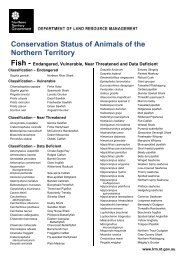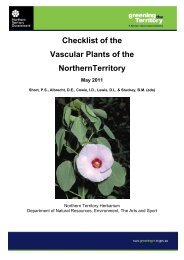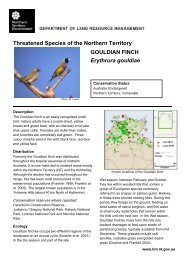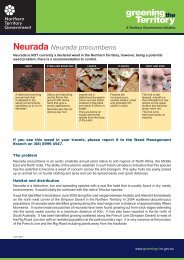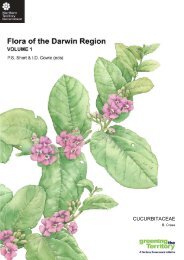DILLENIACEAE - Department of Land Resource Management ...
DILLENIACEAE - Department of Land Resource Management ...
DILLENIACEAE - Department of Land Resource Management ...
You also want an ePaper? Increase the reach of your titles
YUMPU automatically turns print PDFs into web optimized ePapers that Google loves.
A similar, undescribed species occurs in the<br />
Marrawal Plateau region in the north <strong>of</strong> Nitmiluk<br />
N.P. It has coarser stems, mostly axillary flowers,<br />
and acute to obtuse calyx lobes.<br />
H. haplostemona J.W. Horn<br />
Pachynema diffusum Craven & Dunlop<br />
Short-lived subshrub to 0.3 m high. Stems weak,<br />
prostrate or decumbent, diffuse, subterete (<strong>of</strong>ten<br />
strongly angled). Leaves not persisting, alternate or<br />
in pseudowhorls, the petiole to c. 25 mm long;<br />
lamina ovate to elliptic and decurrent, 20–50 mm<br />
long, 8–23 mm wide, the midrib impressed on the<br />
upper surface and prominent on the lower<br />
surface, the primary veins obscure on the upper<br />
surface and raised on the lower surface, the<br />
margin incised-serrate with scabrous trichomes on<br />
the margin. Flowers mostly on naked peduncles 4–<br />
20 mm long, without a subtending bract, or<br />
terminating the principal stems. Sepals about equal<br />
in size and shape, oblong or elliptic to slightly<br />
obovate, sometimes a few mucronate, c. 3 mm<br />
long. Petals oblong to spatula, c. 3 mm long, red,<br />
the margin entire, persistent. Stamens 5, in a single<br />
series, 1–1.2 mm long; filament ovate in outline,<br />
flattened towards the base, the apex sloping<br />
towards the carpels and depressed-obovate (1:2)<br />
in section; smooth to subpapillate and gibbose in<br />
general form; anther not differentiated and the<br />
thecae embedded in apex <strong>of</strong> filament, c. 0.4 mm<br />
long, dehiscence introrse with the slit longitudinal.<br />
Carpels 2, 1.1–1.6 mm long; style 0.1–0.2 mm<br />
long. Seed spheroidal, 2.8–3 mm diam. Flowering &<br />
fruiting: Feb.–May.<br />
Fig. 5 (Fryxell 4229; Wightman 1339); Pl. 11 (Cowie<br />
10364); Pl. 12 (Kerrigan 791).<br />
Endemic to the N.T. Known from the Alligator<br />
rivers region, Litchfield N.P. and Fitzmaurice<br />
River, where it grows on exposed sandstone;<br />
<strong>of</strong>ten with spinifex (Triodia spp.).<br />
Hibbertia haplostemona was coined as a new name<br />
for this species by Horn (2009), the name H. diffusa<br />
R. Br. ex DC. already existing for another species.<br />
H. juncea (Benth.) J.W. Horn<br />
Pachynema junceum Benth.<br />
Rhizomatous subshrub, erect, to 1.5 m tall. Stems<br />
dimorphic, the shorter stems much-branched with<br />
terete to compressed branchlets, the taller stems<br />
less-branched, the stems up to 5 mm wide, the<br />
branchlets 1–2 mm wide. Leaves not recorded.<br />
Peduncle 1–5 (8) mm long. Sepals unequal and<br />
sometimes strongly so; outer sepals ovate to<br />
<strong>DILLENIACEAE</strong> 13<br />
orbicular, 2.5–3.5 mm long; inner sepals ovate to<br />
elliptic, 3.25–5 mm long, margins entire and<br />
minutely ciliate. Petals elliptic to widely elliptic to<br />
orbicular, 3.75–5.5 mm long, white, cream, cream<br />
tinged pink, or deep pink, papillate, margins<br />
crenulate for the distal four-fifths or nearly to the<br />
base. Stamens and staminodes in 2 series, outer series<br />
with 7–10 stamens (occasionally with one <strong>of</strong><br />
these reduced to a staminode), inner series with<br />
2 staminodes. Stamens 2–2.8 mm long; filament<br />
papillate, suborbicular to elliptic, the apex<br />
acuminate, 1.6–2.4 mm long, transversely elliptic<br />
to transversely narrowly elliptic (1:2 to 1:3) in<br />
section; anthers ovate to suborbicular, thecae<br />
divergent to subparallel, 0.3–0.7 mm long,<br />
dehiscence latrorse with the slit longitudinal.<br />
Carpels 2, 2.3–2.5 mm long; style 1.3–1.5 mm<br />
long. Seed spheroidal to slightly depressedspheroidal,<br />
4–4.8 mm diam. Flowering & fruiting:<br />
Nov.–Aug.<br />
Fig. 4 (Evans 3649); Pl. 13 (Kerrigan 787).<br />
Endemic to the N.T. The most common species<br />
in the immediate environs <strong>of</strong> Darwin but<br />
widespread from the Victoria River area to northeast<br />
Arnhem <strong>Land</strong>. In savanna on lateritic and<br />
sandy soils.<br />
H. praestans (Craven & Dunlop) J.W. Horn<br />
Pachynema praestans Craven & Dunlop<br />
Subshrub 1.5 to 2 m high. Stems single or several,<br />
much-branched and broom-like, branchlets<br />
pendulous; larger stems smooth, <strong>of</strong>ten with areas<br />
<strong>of</strong> flaking pale-coloured cuticle; branchlets <strong>of</strong>ten<br />
angular, sometimes terete. Leaves not recorded.<br />
Peduncles solitary or 2 together in axils <strong>of</strong> bracts,<br />
naked or with 1–3 basal bracts, narrowly clavate,<br />
3.5–17 mm long. Flower base constricted to form a<br />
thick pedicel 0.8–1.2 mm long. Sepals unequal; the<br />
two smallest elliptic, acute, 2.5–3 mm long; the<br />
three largest about equal, oblong to slightly<br />
obovate, 3.2–5 mm long. Petals 5, elliptic (2 or 3<br />
slightly conduplicately folded), 3–4 mm long,<br />
persistent, dark red, minutely and densely<br />
papillate. Stamens 4 (rarely 5), in a single series,<br />
1.5–2 mm long; filaments smooth, flattened,<br />
transversely linear (1:12) in section, 1–1.2 mm<br />
long; anthers not clearly differentiated, the thecae<br />
divergent, 0.5–0.8 mm long, dehiscence introrse<br />
with the slit longitudinal. Carpels 2, 2–2.1 mm<br />
long, the style 0.8–1 mm long. Seeds spheroidal to<br />
slightly depressed-spheroidal, 2.1–2.8 mm diam.<br />
Flowering & fruiting: Dec.–Aug.<br />
FDRV1 March 2011


